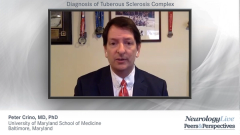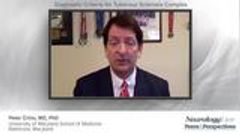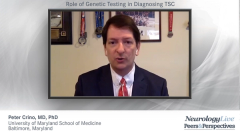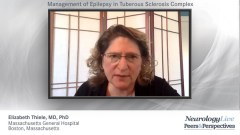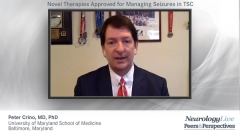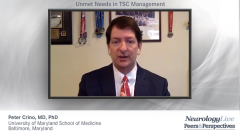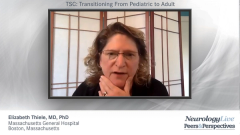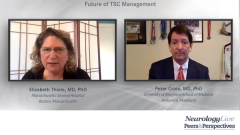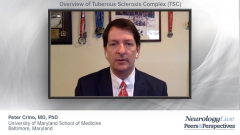
Future of TSC Management
Advice to community neurologists for the optimal care of patients with tuberous sclerosis complex and future directions for TSC.
Episodes in this series

Elizabeth Thiele, MD, PhD: For community neurologists, what advice would you give them? I often will see a patient with TSC [tuberous sclerosis complex] who has been followed, as a neurologist, the focus is on the epilepsy, the behavior, the autism, etc. What’s the advice for community neurologists, not to feel that they have to have the burden of taking on all aspects of the care of an individual with TS, but what advice would you give? How would you approach taking care of either a child or an adult as a community neurologist?
Peter Crino, MD, PhD: It’s a challenging disorder to follow, you have to keep juggling a bunch of balls in the air at the same time. Unfortunately, many neurologists, community neurologists in particular, end up being the point of service for patients with TS. They often do a fabulous job with the epilepsy, the behavior, and getting them connected for an IEP [individualized education plan], and all that sort of stuff. But they may not think about the evolution of kidney disease or progressive changes in terms of facial angiofibromas and cosmetic effects. In women, as they transition to adolescence, the appearance now and new burden, the new risk of potentially developing LAM [lymphangioleiomyomatosis], often is not acknowledged. The biggest thing I tell community neurologists, and I work with a lot of them, is that the surveillance criteria, the diagnostic criteria, not only are they published, they are on the website for the TSC Alliance. You can go and you can find them, and they’re pretty simple to follow.
They’re pretty straightforward. I also tell them that if they can’t find a center of excellence or a clinic center to go to, to feel free to have patients be seen by either nephrology or pulmonology or dermatology, so you get a multitude of opinions. It does take a village in a lot of ways. We as TSC specialists, we’re used to thinking about all the different organ systems. If you’re a community neurologist, you may not have thought about checking somebody’s glomerular filtration rate recently, or you haven’t thought about checking their pulmonary function test. It’s important to get other opinions to make sure you’re getting in front of the problems that evolve in TSC because that’s how you can stay on top of this disease.
Elizabeth Thiele, MD, PhD: I agree. I would promote the TSC Alliance. I can be an expert in tuberous sclerosis or maybe a few other things, but there are a lot of things I don’t know as much about and the right way to provide care for patients. I think having the TSC Alliance so easy to go to, to access information, to access advice, to be connected to peers; it’s an incredible network. I think that it not only improves the lives of people living with TS, but it supports those providing care to people living with TSC.
Peter Crino, MD, PhD: You’re right.
Elizabeth Thiele, MD, PhD: We mentioned the turning point and where we need to go. But if you had to say what you consider the biggest unmet needs in TS, other than a cure, a cure would be great….
Peter Crino, MD, PhD: A cure’s great.
Elizabeth Thiele, MD, PhD: What would be on your top 5 wish list?
Peter Crino, MD, PhD: That’s a hard one. I think certainly something to get a better sense of the prognostic landscape for any individual. It’s very difficult for any one person to come in and tell them what the next 5 or 10 years hold. It is particularly relevant for kidney disease and lung disease, especially lung disease. So, being able to identify persons at risk with either biomarkers, blood biomarkers, tissue biomarkers, imaging biomarkers, but something that allows you to get a handle on what’s coming. As I said before, I try to lay the groundwork, but it’s all just a series of what-ifs. It would be nice to have some plans to say, “Look, we have this blood test, and it looks like you’re at pretty high risk of developing LAM or kidney disease, etc.” I think a prognostic biomarker would be huge. I think, as you mentioned earlier, the wholesale analysis of babies to identify those at risk for TSC, whether through a whole newborn screening program to assay the way we do for other types of genetic diseases, or in individuals at high risk.
As you mentioned, going forward, that early disease-modifying therapy, even in the first few days of life, and dare I say it, maybe even the third trimester, may have significant alterations in what the long-term outcome is in terms of neurocognitive development. I think that would be a game-changer. To take TSC, as opposed to a multisystem disorder plus autism, for example, to just a multisystem disorder with normal behavior and normal intellect. I think those are very different engagements in terms of patient care. No. 3, I think we’re going to have to look a little more at, even though we have good therapies right now for TSC, there are still some [adverse] effects that are difficult for patients, that limit their wide-scale deployment and their utility. Some people actually have to come off the medicines that we have because of [adverse] effects.
I think we need a better sense of the next generation of medicines that have fewer [adverse] effects, are more tolerable, easier to dose. I would also include, do we really need to dose medications every day? Could we come at it from a cancer chemotherapeutics perspective, where we do maybe intermittent or periodic dosing? I think that would be fabulous. The final point, which is still largely aspirational, is at the end of the day, tuberous sclerosis complex is a genetic disease. There have been a number of advances in the last 5 years, certainly in the neurological disease space, where we have used gene editing to begin to alter the course of a neurologic disease. Some of them, in the case of spinal-bulbar muscular atrophy, are really serious pediatric diseases, and we’ve changed the course.
We have to think about how gene therapy might be a tractable option in TS to be able to either mitigate or indeed reverse the effects of the gene mutations and undo what nature has done in terms of gene mutations. I think that’s very aspirational, it’s almost a bit of science fiction. The truth of the matter is, in the last 5 years, we’ve made progress in gene editing, in altering human phenotypes and diseases, and improving lives.
Elizabeth Thiele, MD, PhD: I completely agree. I get that question a lot from patients because, gene therapy, they read about it in different disorders. There’s a lot of excitement now, like in Dravet syndrome with the ASO [antisense oligonucleotide] trial going on, and will those be possible in TS? I’ve had this discussion with some people in the gene therapy industries who view TS as a little different than spinal muscular atrophy.
I think if you look at the burden of the possibilities, the various spectrum of involvement of TS as well as the years of surveillance, if you did have gene therapy, not only could you improve the lives of people living with TS, probably dramatically. But you could also probably end up saving health care dollars because you wouldn’t be doing all the MRI scans, necessarily, etc. I agree, it’s aspirational, and I think many of us hope that there will be a possibility for it someday. There clearly is with these other disorders that have trials in place that show promises, that the future is bright.
Peter Crino, MD, PhD: Absolutely.
Elizabeth Thiele, MD, PhD: What you said about prognostication, I think that also would be huge. If I was counseling a young man or a young woman about family planning, who had TS, that’s a very difficult aspect of what we do. If I had TS and was mildly affected, right now no one would be able to promise me my child would be as well. Maybe, if we can do preventive therapy if we know a baby’s going to have TS, and we modify, but I think that’s also difficult. As we know, to date, the genotype-phenotype correlations we’ve all tried to hunt down and pick up so far haven’t been that clear and helpful, other than TSC2 [mutations] often being more severe than TSC1.
I’d like to thank the audience for watching this NeurologyLive® webinar. If you enjoyed the content, please subscribe to our e-newsletters to receive upcoming programs and other great content right in your inbox.
Transcript Edited for Clarity
Newsletter
Keep your finger on the pulse of neurology—subscribe to NeurologyLive for expert interviews, new data, and breakthrough treatment updates.

